Traditional Amazonian medicine revolves around the use of “master plants”. The term master plants refers to a specific group of age-old plants used both for their medicinal properties as well as for their “teaching” qualities. Ayahuasca, Tobacco, Coca and Datura are included in this group. The term teacher may seem absurd but it is perfectly justified. In the context of traditional medicine, the master plants directly address the individual and deliver messages in the form of visions (visual, auditory, sensitive, dreamlike, …). The visions they induce vary according to the cognitive material of each but the teaching remains substantially the same. It is largely facilitated by the healer (curandero) who accompanies the patient in his process of care by sharing his medicine: a positive and complete sum, the fruit of thousands of years of connection with nature, knowledge many times shared and transmitted, whose goal is to change the consciousness and the relationship to the world.
Master Plants as Diet Plants
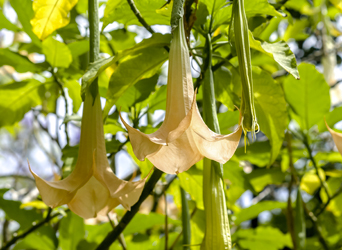
If we try to imagine the family of Amazonian master plants, we could find in the center Ayahuasca, Tobacco, Coca, Datura, which we can call “visionary plants”, and around these plants the extended family represented by master plants. master plants such as Piñon Blanco (Jatropha Curcas L.) or Ajo Sacha (Mansoa alliacea) are also visionary plants with teaching and healing qualities, but to access the visionary world of their medicine it is necessary at the beginning to use Ayahuasca or Tobacco. The patient will have to follow a Diet process if he(she) wants to connect with it. Master plants are no less powerful plants used to treat different diseases, help to rebalance energy, help the healer to make a diagnosis, and provide the patient with the clairvoyance that was lacking. However, when the patient’s state of health is of concern, the healer will first prescribe a treatment consisting of one or more medicinal plants. The patient will not be able to drink Ayahuasca as long as his health is threatened, but he will receive care during ceremonies. Later, when his strength is back, he will be able to drink Ayahuasca and connect to a master plant, to begin a deeper work.
Master Plants and Ceremonies of Ayahuasca
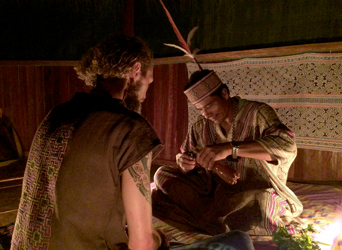
At a Ayahuasca ceremony, the healer will make a diagnosis of his patient and prescribe treatment. : the diet. The treatment may include one or more master plants and last longer or shorter depending on the purpose or complexity of the case to be treated. Supported by his icaros (sacred songs) and his knowledge, the healer will be able to identify the master plant that the patient will have to accompany the process of care. Once the master plant is identified, the healer opens the connection between the plant and the patient. By accumulating the energy of his master plant, the dietero (dieter) will gradually weave an intimate relationship with it, notably through the ceremonies of Ayahuasca, allowing him to feel better and to have visions of the spiritual world of his plant. Click on the following link to learn more about diets of master plants.
With regard to the master plants, we often hear that they modify or alter the consciousness. This is not correct. They have the capacity to change our perception of reality, the reality obviously remaining the same. This change in perspective highlights the shadows, it tells us the changes that must be made to bring love and unity back into our lives. On the other hand, it is the action of change that causes the modification of consciousness.
« ...sooner or later you're going to realize just as I did that there's a difference between knowing the path and walking the path. »
— Matrix
Ayahuasca and Tobacco
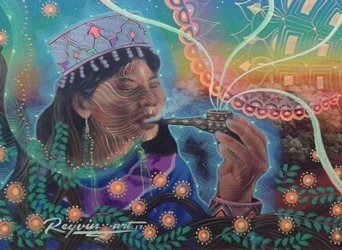
One of he master plant most unknown but most consumed in the world is undoubtedly Tobacco. If we approach the subject of Tobacco it is not to open a polemic on its current use but to observe it from the angle of the traditional medicine of Ayahuasca. Tobacco, as everyone knows, has been used for millennia by Native American communities. Appreciated for its qualities of mediator and amplifier, it facilitates reflection and communication with the spirits. In the Amazon, it is also used a lot especially during ceremonies. It is common for a healer to smoke tobacco, either because he wants to amplify his visions, or because he blows tobacco smoke on his patients to treat them. The strong smell of tobacco can indeed help a patient to vomit or allow him to concentrate when the drunkenness of Ayahuasca (mareacion) has given way to confusion and panic. Of course, the use of tobacco is not limited to that. There are also healers who work exclusively with Tobacco (Tabaqueros). The Tobacco diet can be very effective in treating cases of tobacco addiction.
Master Plants commonly used in Peru
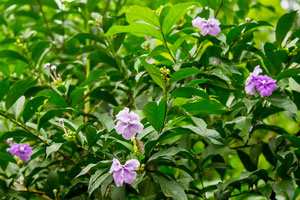
Chiric Sanango (Brunflesia Grandiflora): A shrub with deep roots that grows naturally in the shade of dense Amazon forests. Its name means cold plant, because of the sensation of cold that it produces in the body after having ingested it. It actively works on the patient’s dreams. It is especially recommended for drug addicts, people with addictions, or those who lacked love during childhood. It is also prescribed by healers for elderly people with rheumatism and bone problems.
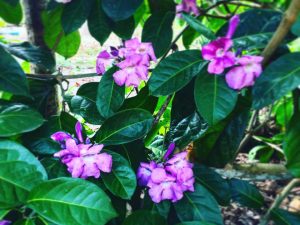
Ajo Sacha (Mansoa alliacea): Means wild garlic. Liana has thick leaves with a strong smell of garlic. It is widely used for all types of infections, and develops immune defenses. Ajo Sacha is a fire plant, producing a feeling of heat and muscle pain. Ajo Sacha acts on both the body and the mind. It is particularly present in dreams and helps the patient eliminate trauma and fear. It activates self- confidence and helps to recover faith in life. According to the healers, this plant is recommendable for people with lung problems, smokers, and immuno-deficiency.

Piñón Blanco (Jatropha Curcas L.): Tree with resinous leaves. Also produces seeds used as a purgative (see purge). It is prescribed in the case of patients looking for spiritual connection, loss of bearings or cut off from their feelings. It helps to connect with one’s soul and inner light, to soften angry and irascible temperaments, to facilitate the flow of energy through the chakras.

Marosa (Calathea allouia): a bushy plant recognized as the plant of the “heart”, it works on emotional wounds, trauma and sadness, cleaning up old memories that may include the genealogical line. This plant is suitable for depressed people. During a Diet, it fills one with joy and confidence and instills self-love. Allows refocusing on “oneself” and listening to one’s bodily feelings.
Master Plants and Perfumes
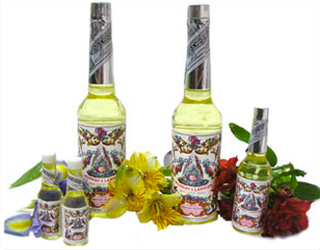
In Traditional Amazonian medicine, smells have the power to influence our emotional state. This is corroborated by studies demonstrating the scenting action of essential oils on certain brain receptors. Like tobacco, healers also use different perfume scents to treat their patients. To influence odors, the healer uses the fragrance of fragrant plants on his patients in the manner of Tobacco by blowing it on the head, on the hands, or on the body. For the composition of a perfume, the healer uses a base of cologne (the most common being the Agua de Florida) in which he can add master plants according to their specificities. The perfumes carry a healthy and positive energy, able to guide serenely the patient in his experience. We know the enchanting power of perfume, but at a ceremony in Ayahuasca, when the senses are awakened, this power is increased tenfold. This proves to be a particularly effective medicine to cure sentimental disappointments and self-destructive patterns, but it must be handled with caution. We are talking here about specific types of perfume. It is also recommended to arrive at an Ayahuasca ceremony showered with a neutral smell (avoid conventional perfumes).

Comments